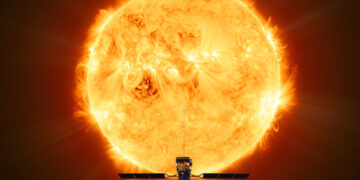For decades, astronomers have been captivated by the Sun’s solar wind—a powerful stream of charged particles that extends throughout the Solar System. This constant outflow of plasma, traveling at speeds of 400 to 800 km/s, shapes space weather, affects planetary atmospheres, and influences communication systems on Earth. However, one question has puzzled scientists for years: What powers the solar wind?
What is the Solar Wind?
The solar wind is an ongoing flow of charged particles (plasma) that emerges from the Sun’s outer layer, the corona. It extends well beyond Pluto and defines the heliosphere, the Sun’s vast sphere of influence in interstellar space.
Two Types of Solar Wind:
- Fast Solar Wind: Travels at approximately 800 km/s, originates from coronal holes, and remains relatively stable.
- Slow Solar Wind: Moves at around 400 km/s, is more variable, and is associated with the Sun’s equatorial regions.
This solar wind directly affects Earth, creating auroras, influencing satellite operations, and impacting power grids. Understanding what fuels it has been a central goal for solar physicists.
Discovery of Tiny Plasma Jets (Picoflare Jets)
The Solar Orbiter, a mission by the European Space Agency (ESA) launched in 2020, has delivered unprecedented high-resolution images of the Sun. Using its Extreme Ultraviolet Imager (EUI), researchers spotted hundreds of tiny jets of plasma erupting across the Sun’s surface.
Key Characteristics of Picoflare Jets:
- They measure a few hundred kilometers wide—tiny compared to the Sun.
- They last only a few seconds before fading away.
- These jets appear in coronal holes, regions of open magnetic field lines from which the solar wind flows.
Before this discovery, scientists suspected that nanoflares—smaller versions of solar flares—played a role in heating the corona and driving the solar wind. However, this new research suggests that picoflare jets could be the missing link, constantly supplying energy to sustain the solar wind.
The Role of Magnetic Reconnection
So, what causes these tiny jets? The answer lies in a process called magnetic reconnection—a fundamental event in plasma physics.
- Magnetic reconnection occurs when twisted magnetic field lines snap and reconnect, releasing vast amounts of energy.
- This is the same mechanism that powers large solar flares and coronal mass ejections (CMEs).
- Picoflare jets continuously eject plasma, adding to the overall energy supply that fuels the fast and slow solar wind.
Why Is This Discovery Important?
1. Solving a Long-Standing Mystery
For years, scientists struggled to explain why the Sun’s outer atmosphere (corona) is significantly hotter than its surface. This discovery suggests that picoflare jets contribute to heating the corona, addressing this long-standing solar paradox.
2. Understanding Space Weather and Its Effects on Earth
The solar wind is responsible for space weather, which impacts:
- Satellites and GPS systems by disrupting signals.
- Astronaut safety by increasing radiation exposure.
- Electrical grids by inducing geomagnetic storms.
- Auroras, the stunning lights seen at high latitudes during solar activity.
3. Preparing for Future Space Exploration
As humanity ventures further into space, from Mars missions to lunar bases, understanding solar wind interactions will be critical for ensuring astronaut safety and designing spacecraft capable of withstanding high-energy particle exposure.
Broader Implications for Astrophysics and Space Exploration
Beyond understanding the Sun, picoflare jets could provide insights into other astrophysical objects that emit plasma winds, such as:
- Other stars with similar stellar winds that influence their planetary systems.
- Accretion disks around black holes, where plasma dynamics play a crucial role.
- Exoplanets that experience atmospheric stripping due to intense stellar winds.
This means that findings from Solar Orbiter could inform studies beyond our own Solar System, helping astronomers understand plasma behavior in various cosmic environments.
Future Research and Next Steps
While the discovery of picoflare jets is groundbreaking, scientists aim to deepen their understanding by:
- Using the Parker Solar Probe: NASA’s Parker Solar Probe, currently the closest spacecraft to the Sun, is expected to provide complementary data.
- Tracking More Plasma Jets: Future missions will study how frequent and widespread these jets are across different regions of the Sun.
- Developing Solar Weather Models: Incorporating this new data will improve space weather predictions, benefiting both Earth and space missions.
- Investigating Energy Transfer Mechanisms: Scientists aim to explore how the energy from these tiny jets accumulates to drive the larger-scale solar wind.
Conclusion: A Small Discovery With Big Implications
The detection of tiny picoflare jets by ESA’s Solar Orbiter has provided a crucial piece in the puzzle of the solar wind’s origins. These minuscule plasma bursts, once overlooked, may be one of the most important contributors to the powerful stream of charged particles shaping the Solar System.
Reference:
Coronal hole picoflare jets are progenitors of both fast and Alfvénic slow solar wind



















